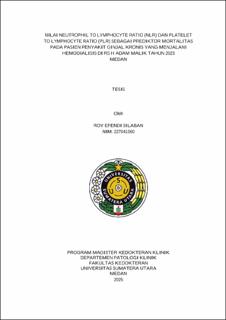Nilai Neutrophil To Lymphocyte Ratio(NLR) dan Platelet To Lymphocyte Ratio (PLR) sebagai Prediktor Mortalitas pada Pasien Penyakit Ginjal Kronis yang Menjalani Hemodialisis di RS.H.Adam Malik Tahun 2023 Medan
Neutrophil-To-Lymphocyte Ratio (NLR) and Platelet-To-Lymphocyte Ratio (PLR) as Predictors of Mortality in Chronic Kidney Disease Patients Undergoing Hemodialysis at H. Adam Malik General Hospital, Medan, in 2023

Date
2025Author
Silaban, Roy Efendi
Advisor(s)
Arto, Nindia Sugih
Lubis, Mohammad Riza
Metadata
Show full item recordAbstract
Introduction: Chronic Kidney Disease (CKD) remains a condition associated with relatively high mortality rates, especially among patients undergoing hemodialysis (HD). The Neutrophil-to-Lymphocyte Ratio (NLR) and Platelet-to-Lymphocyte Ratio (PLR) values have been identified as inflammation markers that potentially predict mortality. This study aims to assess the role of NLR and PLR as predictors of mortality in CKD patients undergoing HD at H. Adam Malik Hospital in Medan. Methods: This study employed a retrospective analytical design with a cross-sectional approach. Inclusion criteria were: CKD patients receiving inpatient care from January 2023 to December 2023, aged between 18 to 60 years, and undergoing routine HD for at least 3 months. Exclusion criteria included: patients with comorbidities (autoimmune diseases, malignancies, chronic conditions leading to elevated NLR and PLR), those with a history of steroid or immunosuppressant use, and incomplete medical records. Demographic data, laboratory values (including NLR and PLR), and mortality outcomes were collected from medical records. Laboratory data were obtained at the 3rd month after initiating HD therapy. Statistical analysis included ROC curve analysis to determine optimal NLR and PLR cut-off points, and logistic regression to identify factors influencing mortality. Results: A total of 108 CKD patients undergoing HD from January to December 2023 were included. Among them, 35 patients (32.4%) experienced mortality. The median NLR value was significantly higher in the mortality group at 7.89, compared to 3.41 in the non-mortality group (p <0.001). The median PLR value did not show a statistically significant difference, with 144.73 in the mortality group and 158.87 in the non-mortality group (p = 0.916). ROC analysis indicated that NLR had moderate accuracy (AUC = 73.3%), with an optimal cut-off value of 5 (sensitivity 62.9%, specificity 75.3%). Conversely, PLR showed poor accuracy as a predictor of HD patient mortality (AUC = 49.4%). Multivariate analysis identified history of coronary artery disease (OR = 380.166), age (OR = 1.140), and creatinine level (OR = 0.689) as significant factors influencing mortality. Conclusion: NLR can be used as a predictor of mortality in CKD patients undergoing HD with moderate accuracy, whereas PLR does not have predictive value for mortality. History of coronary artery disease, age, and creatinine level are dominant factors influencing mortality.
